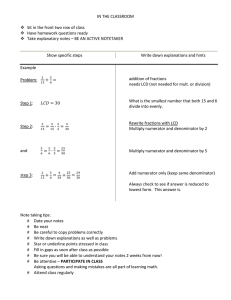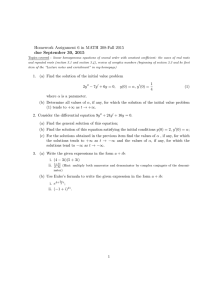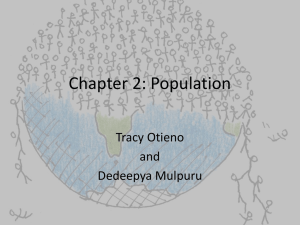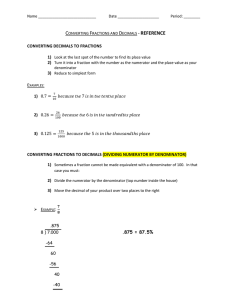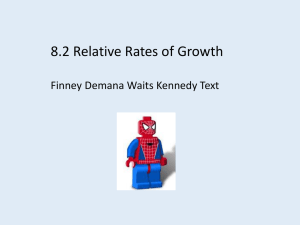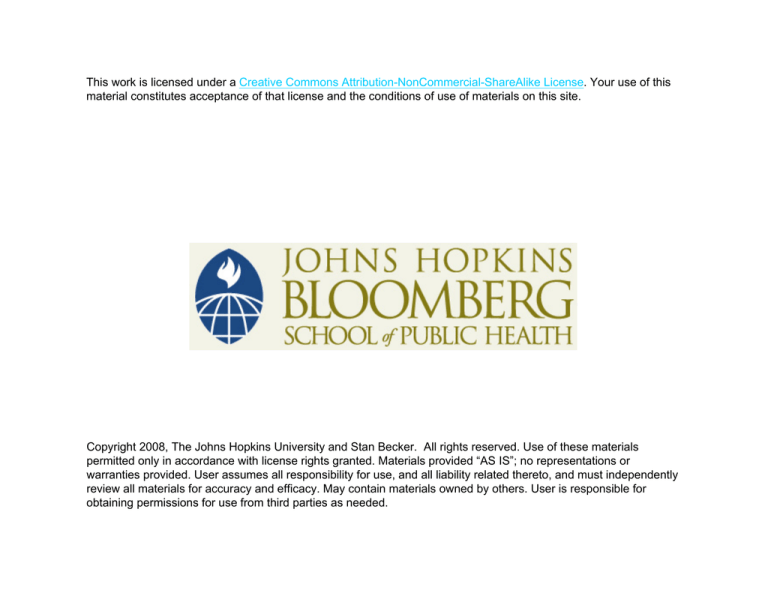
This work is licensed under a Creative Commons Attribution-NonCommercial-ShareAlike License. Your use of this
material constitutes acceptance of that license and the conditions of use of materials on this site.
Copyright 2008, The Johns Hopkins University and Stan Becker. All rights reserved. Use of these materials
permitted only in accordance with license rights granted. Materials provided “AS IS”; no representations or
warranties provided. User assumes all responsibility for use, and all liability related thereto, and must independently
review all materials for accuracy and efficacy. May contain materials owned by others. User is responsible for
obtaining permissions for use from third parties as needed.
Ratio, Rate, and Probability
Stan Becker, PhD
Bloomberg School of Public Health
Ratio
Value obtained by dividing one quantity by
another
Indicates the relative magnitude of a
numerator and a denominator
Ratios tend to be descriptive statistics
3
Ratio: Examples
Sex ratio at birth (male births per 100
female births)
Child-woman ratio (number of children
aged 0 to 4 years divided by the number of
women aged 15 to 44 years or 15 to 49
years)
Dependency ratio (population aged under
15 or over 64 divided by the population
aged 15 to 64 and multiplied by 100)
Continued
4
Rate
Measure of the frequency with which an
event occurs in a defined population during
a given length of time
Rates are special cases of a ratio
Rates tend to be associated with
population change
Continued
5
Rate
Numerator: Count of events that occur
during a period
Denominator: Midpoint population, or
person-years, or other person-time units of
exposure for the same period as the
numerator
– Persons exposed to the event are
included in the denominator, but others
can also be included
6
Crude Rate
The number of events is divided by the
total population
– Problems:
• Denominator contains some
individuals not susceptible to the
event
• Is affected by age structure of the
population; makes comparison
between populations difficult
7
Rates
Crude birth rate
Number of births in a specific year
Mid - year population for same year
Crude death rate
Number of deaths in a specific y ear
Mid - year population for same year
Rate of natural increase
Crude birth rate - Crude death rate
Continued
8
Specific Rate
Specific rate—The number of events is
divided by some homogeneous sub-group
of the total population
Age-specific death rate—Deaths in a
specific age group divided by the mid-point
population of that age group
9
Probability
In demography, indicates the likelihood
that some event will (or will not) occur to
some group of exposed persons during the
course of some period of time
Similar to rates except that they consider
the number of people exposed to risk at
the start of a time interval instead of the
average number exposed (midpoint
population)
Probabilities are special cases of a ratio
Continued
10
Probability
Probability of dying between birth and age
five—Probability that a child will die
between birth and exact age five
Probability of surviving from age 20 to age
25—Probability that a person of exact age
20 will survive to exact age 25
11
Summary
Most indices developed by demographers
to describe a population are expressed in
the form of ratios, rates, or probabilities
However, the distinction between ratio,
rate, and probability is not always clear-cut
Continued
12
Summary
Infants deaths in year x
Infant mortality rate =
Live births in year x
Continued
13
Summary
Infant mortality rate
– Is not a rate in the technical sense since
the denominator is not in terms of midyear population or person-years of
exposure
– Is not a probability since the numerator
includes events to births not included in
the denominator
– Should thus be regarded as a ratio,
though it is called a rate
14



